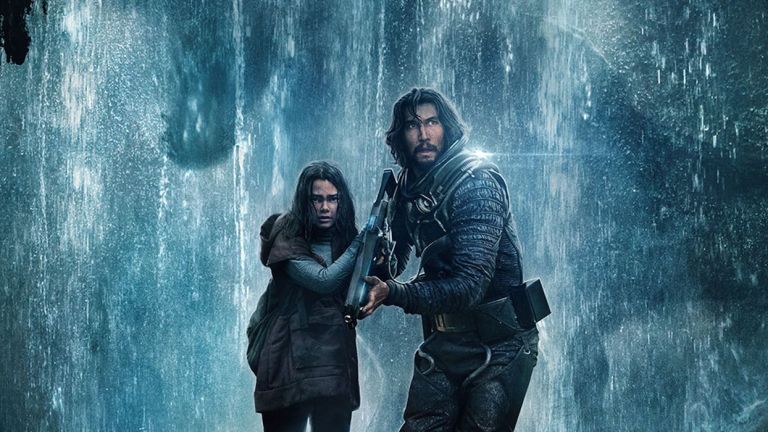65 and Dinosaur Movies Need to Move Past Jurassic Park
65 is a dinosaur movie that thinks the best way to be not-Jurassic Park is to turn the prehistoric creatures into scary monsters. Yet why not go the other way, and usher in the age of feathered dino movies?

This article contains 65 spoilers.
65 is a movie about aliens crash landing on Earth during the age of the dinosaurs. Except that the aliens look an awful lot like they come from Earth, and the dinosaurs… don’t.
The dinosaurs presented in writer-directors Scott Beck and Bryan Woods’ film might have some recognizable body parts, and some may even bear a passing resemblance to a few of the bigger names from the My First Dinosaur book you had as a kid, but for the most part, the giant killer reptiles we see in that movie are monsters, nothing more, and nothing less. At one point there is a baby dinosaur that looks like a cross between a T-Rex and an Ankylosaurus, a species so far unknown outside of one episode of the Lego Jurassic World animated series. And while the fossil record is incomplete, and there may have existed many species of dinosaur we are unaware of, the liberties the film takes go far beyond that.
Paleontologists have already pointed to a giant, four-legged T-Rex creature that is a total invention for the movie. As far as we can tell, all meat-eating dinosaurs walked on two legs, with their legs positioned more like a chicken’s legs than a crocodile’s. And that’s ignoring the fact the film’s title and opening text place it roughly a million years after dinosaurs became extinct.
But the biggest issue dinosaur aficionados have with 65, and it’s a recurring problem, is plumage. Everything we know about dinosaurs today leads us to believe that dinosaurs were feathery boys and girls. They didn’t look like the giant lizard you have to fight in a Dungeons & Dragons game. They looked fabulous.
And 65 is not alone in this. So the big question is, why?
They didn’t stop to think about whether they should
The baseline for all dinosaur movies of the last 30 years (with apologies to all our readers who said “That can’t be right,” then googled it, then sat quietly for a few moments wondering where the years went) is Jurassic Park.
When Jurassic Park was released, it featured groundbreaking special effects, but that wasn’t the reason it captured the school lunchbox market for the next five years. It was beloved because, to its nine-year-old audience at least, it was the closest they would ever get to seeing an actual dinosaur. These dinosaurs weren’t movie monsters; they moved and acted, and sounded like animals. The sort of “monstrous” touches other films might have used, like giving a Velociraptor a forked tongue, were avoided.
The film is peppered with factoids and knowledge in line with the latest and still-developing ideas about dinosaurs of the time. Dinosaurs evolved into birds. Dinosaurs were warm-blooded, active, social animals. Brachiosaurs “don’t live in a swamp.” It’s a thrilling movie, but Jurassic Park also takes every step possible to convince its audience it is seeing what a dinosaur actually looked like. Sure, they turned Velociraptors into six-foot monstrosities rather than the knee-high critters they actually were, even though Deinonychus almost precisely matches the description of the movie dinosaurs but continues to dwell in obscurity. Nobody’s perfect, and one day we will forgive them for their Deinonychus erasure.
But all in all, Jurassic Park was a film that traded heavily on its scientific accuracy by the standards of the time.
And so, from then on, that’s what dinosaurs looked like. The BBC’s Walking with Dinosaurs series, Disney’s Dinosaur (2000), A Sound of Thunder (2005), Journey to the Center of the Earth (2008), Land of the Lost (2009), and of course, Jurassic Park: The Lost World (1997), Jurassic Park III (2001), Jurassic World (2015), Jurassic World: Fallen Kingdom (2018), and Jurassic World Dominion (2022). All of them feature dinosaurs that, to a greater or lesser extent, would be familiar to audiences in 1993.
The biggest dinosaur movie since 1993 not to be about a theme park was Peter Jackson’s King Kong (2005), whose dinosaurs harkened back to the stop-motion creations of the original 1933 movie. Peter Jackson’s dinosaurs are almost all undoubtedly monsters, not animals, but at least have the excuse that they are the result of 66 million years of isolated evolution on Skull Island.
Jurassic Park has, too, sought to justify its adherence to Dino orthodoxy, with Jurassic World’s Henry Wu (B.D. Wong) basically flat out saying they genetically engineer out the feathers so audiences see dinosaurs that look how they expect. Of course in that same movie, the theme park designs a new, deadlier dinosaur for that same reason. That also does not have feathers. And this goes beyond movies. Check out Britain’s Natural History Museum where you would expect to prioritize accuracy. Yet that is one big scaly T-Rex.
The fact is, the entire dino industry is geared towards showing us dinosaurs not how they were 66 million years ago, but how we thought they were in the early 1990s. But it doesn’t have to be that way.
The case for a more accurate dinosaur
The fact is big scaly monsters with lots of teeth are cool and exciting. We aren’t going to argue any differently. But if that is what 65 wanted to do, then why not have a human astronaut crash his ship on an alien planet full of monsters that actually look like that? The film is set on prehistoric Earth for a reason. Partly that reason is to give the plot that extra bit of resonance, the old Planet of the Apes twist, and that closing shot of the landscape evolving over millions of years until it arrives at the present day.
But the main reason is, obviously, dinosaurs are cool. And the reason that dinosaurs are cooler than, for instance, dragons, is that they were real, they existed, and they walked around probably wherever you are sitting reading this. If our understanding of dinosaurs has changed, if we know that they look different, even surprising to modern audiences, isn’t that also cool? Even scary? Isn’t that something to lean into?
There are those that have tried to break the trend. Apple TV’s Prehistoric Planet is loaded with fuzzy, feathery, colorful dinosaurs behaving in ways you might not see coming. But 65 is not a nature documentary. The dinosaurs and the environment in that film don’t look like that by accident. They look like that because 65 doesn’t want to be Jurassic Park; it wants to be a horror movie.
Remove the dinosaurs and you still have a planet that is decaying and rotten, a world positively asking to be wiped out by an asteroid. It is taking your home and saying “This, here, is the place the astronauts take one look around and say, ‘Let’s get the fuck out of mess.’”
They don’t want the dinosaur nerds sitting there with their spotters’ guide ticking off the ones they recognize like giant, carnivorous Pokémon; they want the space to be creative and show the audience something new. But even there, there are options to do something so much more interesting than the dime store dinos we are given.
The book, All Yesterdays, by C.M. Kösemen, Darren Naish, and John Conway, features many pictures of dinosaurs, but perhaps the most illustrative chapter is its closing one. It opens with a picture of a scaly, skeletal-looking predator with sunken eyes and sharp, prominent teeth at the front of its streamlined head. It is only by reading the caption that you realize this fearsome creature is an ordinary house cat, drawn from a skeleton the way dinosaurs are.
The rest of the book tries to break from those old habits, showing us tree-climbing Protoceratops, camouflaged Majungasauruses disguised as logs, fat fluffy Leaellynasaura, a Therizinosaurus that looks more like Cousin Itt than anything from a dinosaur movie you’ve seen, and a Heterodontosaurus with a spiny tail like a hedgehog.These are ideas based on speculation and imagination, not paleontology, but they are just as, if not more likely to be true as the scaly dragon-a-likes we’re used to. By leaning into that, 65 could have shown us a prehistoric Earth that was truly an alien planet, and perhaps one still thrilling to explore and survive.
